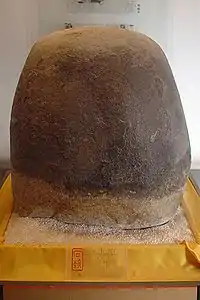Stone Drums of Qin
The Stone Drums of Qín or Qin Shi Gu (Chinese: 秦石鼓; Wade–Giles: Ch'in Shih Ku) are ten granite boulders bearing the oldest known "stone" inscriptions in ancient Chinese (much older inscriptions on pottery, bronzes and the oracle bones exist). Because these inscribed stones are shaped roughly like drums, they have been known as the Stone Drums of Qin since at least the 7th century.[1][2]

Their fame is because they are the oldest known stone inscriptions in China, making them a priceless treasure for epigraphers. The stone drums are now kept in the Palace Museum, Beijing. They vary in height from 73 cm to 87.5 cm (with one which was at one point used as a mortar reduced by the grinding to 58 cm), and from 56 to 80.1 cm in diameter. The Stone Drums weigh about 400 kg. each.
Inscriptions
The ancient inscriptions on them are arranged in accordance with each stone's size and proportions, the largest stone bearing fifteen lines of five characters each, and a smaller one with nine lines of eight graphs each, neatly arranged as if in a grid. The contents are generally four-character rhymed verse in the style of the poems of the Classic of Poetry, a few lines of which they even paraphrase. The contents generally commemorate royal hunting and fishing activities.
Originally thought to bear about 700 characters in all, the Stone Drums were already damaged by the time they are mentioned in the Tang dynasty (618-907 AD) poetry of Du Fu.[3] The drums had only 501 graphs by the Song dynasty (960-1279 AD), when the best rubbings now surviving were made (Mattos, p. 57. Cf. Guo Zhongshu). They have been further damaged through rough handling and repeated rubbings in the years since, and one was even converted into a mortar, destroying a third of it. A mere 272 characters are visible on the stones today. In the best rubbing, only 470 of the 501 characters are legible, or about 68% (Mattos p. 122); after omitting repeated graphs, this leaves us with a treasury of 265 different graphs, 49 of which are known from no other source (excluding recognizable variants). Even among recognizable graphs, scores of them are used in ways unattested elsewhere, leading to great difficulty and disagreement in their interpretation, a situation common to Zhou dynasty inscriptions (Mattos p. 122).
Discovery
The Stone Drums are mentioned in the 7th century, and may have been found within the preceding century. There exists no record of their actual discovery, so the date and location thereof are unsettled, and are a matter of extensive scholarly controversy. Wagner (1990) speculates that the original location of the drums’ discovery may have been the Qin royal tombs or an associated ritual complex in Fengxiang County, Shaanxi Province, but also mentions another potentially relevant location: a mountain named Shígǔshān (石鼓山), or Stone Drum Mt., in Chéncāng (陳倉), about 25 km. SW of Yong (Tianxing), the Qín capital from 677 to 383 BC. Yong’s city walls have been found in Fengxiang, and the Qín royal tombs lie about 11 km. to the south.[4][5][6][7][8]
Dating
Like their discovery, the details of their origin have also long been subject to debate. While most now agree that they were made at the behest of a Duke of the state of Qin, the century of their creation is still uncertain; Mattos (1988) tentatively places them in the 5th century BC. Chén Zhāoróng (2003, p. 9)[9] points out that the style of the Stone Drums script is extremely close to that of the inscriptions on both the Qín Gōng guĭ (秦公簋, a bronze tureen) and a stone qìng (chime), both belonging to Duke Jing of Qin, who ruled from 576 to 537 BC. She states that it is very likely that these artifacts date to the same period, and thus dates the Stone Drums to the late Spring and Autumn period.
Notes and references
- The name 石鼓 Shígǔ, the Stone Drums, is first evidenced in Lĭ Xián’s (李賢; 651-684) commentary on the Book of the Later Han, juan 16, p.11a (cited in Mattos p.21).
- Gilbert L. Mattos, The Stone Drums of Ch'in (Monumenta Serica Monograph Series, 19). Nettetal, BRD: Steyler Verlag, 1988. Paperback, 497 pp. Reviewed by Wagner, D.B. in Acta Orientalia, 1990, 51: 241-256.
- Du Fu wrote: "...陳倉石鼓又已訛..."“("the Stone Drums of Chén Cāng were already corrupted").
- Wagner, Donald B. (1990) Review of “Gilbert L. Mattos, The Stone Drums of Ch'in (Monumenta Serica Monograph Series, 19)” in Acta Orientalia, 1990, 51: 241-256.
- Li Zhongcao, "Shigu zuichu suozai di ji qi keshi niandai", Kaogu yu wenwu, 1981.2: 83-86 + 82; cited by Wagner (1990); also cited by Mattos (1990).
- Han Wei et al.: "Qin du Yong cheng zuantan shijue jianbao", Kaogu yu wenwu, 1985.2.: 7-20. Cited in Wagner (1990).
- "Fengxiang Qin Gong lingyuan di-er-ci zuantan jianbao", Wenwu, 1987.5: 55-65. Cited in Wagner (1990)
- "Qin du Yong cheng kaogu fajue yanjiu zongshu", Kaogu yu wenwu, 1988.5/6: 111-127. Cited in Wagner (1990).
- 陳昭容 Chén Zhāoróng (2003) 秦系文字研究 ﹕从漢字史的角度考察 Research on the Qín (Ch'in) Lineage of Writing: An Examination from the Perspective of the History of Chinese Writing. 中央研究院歷史語言研究所專刊 Academia Sinica, Institute of History and Philology Monograph. ISBN 957-671-995-X.
Further reading
- The Stone Drums of Ch'in by Gilbert L. Mattos, 1988.